Trenton Battle Monument
Introduction
Text-to-speech Audio
Images
The monument was designed by John H. Duncan and is perhaps ironically modeled after a famous British monument
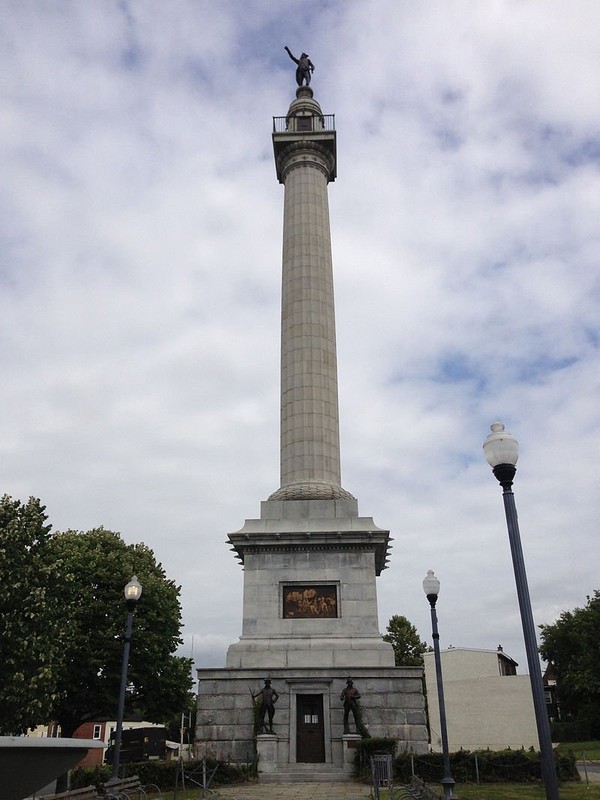
The Eakins bronze relief plaque in this front view depicts the opening of the Battle of Trenton. The central entrance door is flanked by a pair of bronze, full-length figures of Continental soldiers.
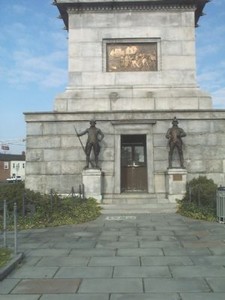
Washington at the Battle of Trenton / Engraved by Illman Brothers from the original in the possession of Charles J. Peterson.
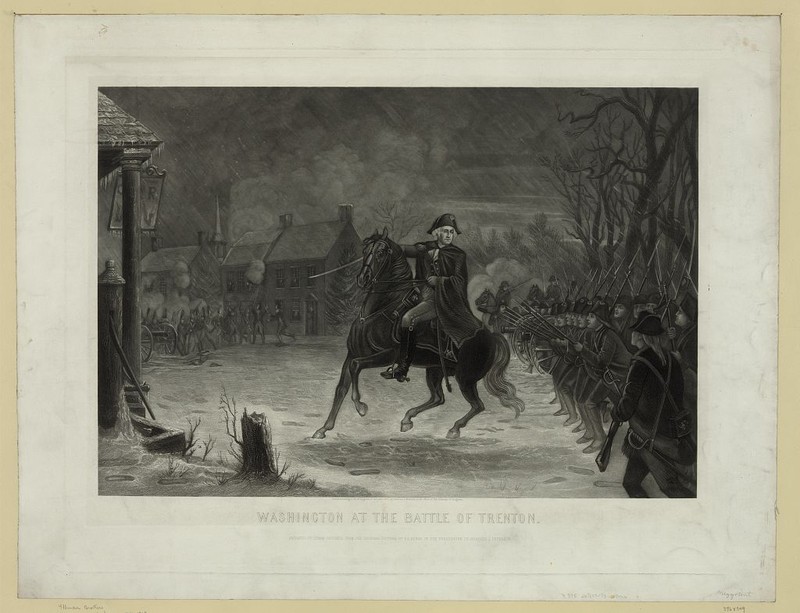
The famous picture of Washington crossing the Delaware
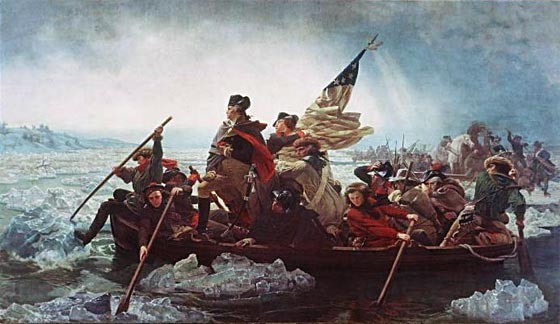
The battle layout
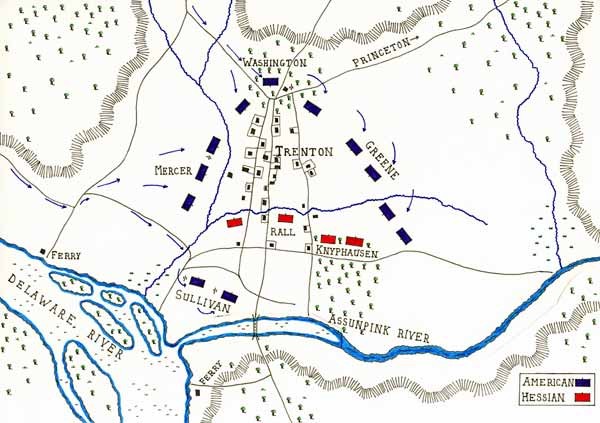
Backstory and Context
Text-to-speech Audio
The Trenton Battle Monument, completed in 1893, commemorates one of the most pivotal moments in American history. On December 26, 1776, General George Washington led his force of 2,400 Continental troops across the Delaware River into Trenton, New Jersey to conduct a surprise attack on Hessian (Germans enlisted by the British) troops. German troops had occupied Trenton since December 14, 1776. Washington was tracking their movements across New Jersey beginning at Fort Lee since November 20. The Continental army had suffered a long string of losses at the hand of the British army and was reeling at the end of 1776, with many of the men’s enlistments due to expire at the end of that year. Washington caught a break when the British chose not to pursue him further and made the decision to set up camp for the winter with belief the harsh weather or renewed fighting in spring would finally end the rebellion. Knowing that he needed to create some positive momentum for the war and capture supplies, Washington asked his men to embark on a final effort for victory.
Washington created a three-pronged attack to strike at night on Christmas that required crossing the Delaware River, believing that Colonel Johann Gottlieb Rall would not expect an attack in the harsh weather. Yet, Rall was warned repeatedly of the attack. The day before American troops embarked on their nine-mile journey, two American deserters crossed the river with word that the American army was ready to move. In addition, a never-identified British spy was in Washington’s headquarters, and sent word to British General James Grant of the attack. He eventually had the message passed along to Rall, but, while telling him to remain vigilant, stated that he did not believe an attack would actually occur. A series of prior false alarms in addition to the growing storm caused Rall to brush off the accusations.
During the crossing of the Delaware River, the thick ice caused two of Washington’s three columns to turn back. The only column to make it across arrived late, on the morning of December 26, 1776. Washington then split this force into two columns commanded by Major General Nathaneal Greene and General John Sullivan, who attacked from different sides and blocked a retreat. Although the American troops had engaged in skirmishes on the outskirts of town, Washington still maintained the element of surprise. With 2,400 American troops against 1,500 Hessians, a majority of the British army, approximately 900 men, were captured, including mortally wounded Rall. Only five Americans had been wounded, with 22 British killed and 83 wounded.
Washington then made his way back across the river with his troops and the captured Hessians to McConkey’s Ferry Inn, where their crossing began. The Hessians, despite their own cruel treatment of American prisoners, were treated well. The 26 Hessian officers were held at the inn that night while the soldiers were brought to Newtown and divided between a prison and Newtown Presbyterian Church. The following day, the Hessian officers were also marched to Newtown, where they were housed in private homes due to their status. Four of the officers met with Washington to provide crucial intel with the mistakes they had made during the battle. Their information assisted Washington in the following Battle of Assunpink Creek to defend Trenton, or the “Second Battle of Trenton,” which occurred just several days later on January 2, 1777 and was again an American victory.
Both the Hessian officers and soldiers were then marched to Philadelphia, paraded through the streets, and settled into barracks. Washington published a proclamation stating that the Hessians were forced into war and were not enemies. Soon, people brought food to the barracks and treated the Hessians kindly. Eventually, the Hessian officers signed a “parole,” which stated they would not interfere with any of Washington’s plans against the British, and were essentially granted free rein (6). The soldiers were taken to Lancaster County to work on the farms, where 23-40 percent remained, with a significant number of them returning to the U.S. with their families at the end of the war.
A movement to erect a monument in honor of the Battle of Trenton began in 1843, and in 1886, property for the monument was purchased by the Trenton Monument Association. To build it, the New Jersey Legislature appropriated $15,000, Congress $30,000, and citizens contributed another $15,000. On December 26, 1891, on the 115th anniversary of the battle, the cornerstone was laid. Two years later, on October 19, 1893, the monument was finally completed and a dedication ceremony was held, attended by eight governors of the original 13 states. The monument stands at the exact location where Washington's canon was located, which prevented a British escape. Designed by John H. Duncan, architect of Grant’s tomb, the monument stands at 150 feet tall, and atop rests a 13-foot bronze statue of George Washington with his arm extended, pointing in the direction the canon faced (down Warren Street). The monument is hallowed and there is an elevator inside enabling visitors to go to the top platform to view the surrounding landscape (it is not clear if this is still possible today). The monument is listed on the National Register of Historic Places.
Sources
- McCullough, David. 1776. Simon and Schuster, 2005.
- Trenton, American Battlefield Trust. Accessed September 12th 2020. https://www.battlefields.org/learn/revolutionary-war/battles/trenton.
- Battle of Trenton, New Jersey. Accessed September 12th 2020. https://www.visitnj.org/article/battle-trenton.
- Trenton Battle Monument, National Heritage Area. Accessed September 12th 2020. https://revolutionarynj.org/storyline_photo2/trenton-battle-monument/.
- Smith, Christopher H.. Battle of Trenton Monument: Site of the American Artillery Emplacement, Library of Congress. Accessed September 12th 2020. http://memory.loc.gov/diglib/legacies/loc.afc.afc-legacies.200003302/.
- What Happened to the Captured Hessians?, Washington Crossing Historic Park. January 29th 2020. Accessed September 12th 2020. https://www.washingtoncrossingpark.org/captured-hessians/.
- Washington at the Battle of Trenton / Engraved by Illman Brothers from the original in the possession of Charles J. Peterson, Library of Congress. Accessed September 12th 2020. https://www.loc.gov/item/2004670529/.
- 10 Facts About Washington's Crossing of the Delaware River, George Washington's Mount Vernon. Accessed September 12th 2020. https://www.mountvernon.org/george-washington/the-revolutionary-war/washingtons-revolutionary-war-battles/the-trenton-princeton-campaign/10-facts-about-washingtons-crossing-of-the-delaware-river/.
Historical Marker Database, by Gary Nigh, December 2007
Library of Congress
American Battlefield Trust
American Battlefield Trust
